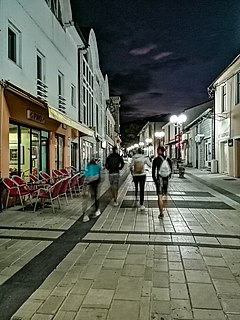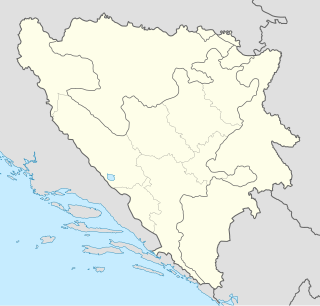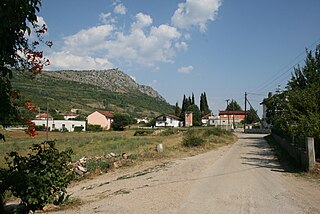Overall
| Type | Number | Percentage | Number change | Percentage change |
|---|---|---|---|---|
| Orthodox Christians | 825,418 | 43.49% | ||
| Sunni Muslims | 612,137 | 32.25% | ||
| Catholics | 434,061 | 22.87% | ||
| Jews | 11,868 | 0.62% | ||
| Others | 14,560 | 0.77% |
Population of Bosnia and Herzegovina in 1910
The 1910 population census in Bosnia and Herzegovina was the fourth census of the population of Bosnia and Herzegovina taken during the Austro-Hungarian Condominium of Bosnia and Herzegovina [1] [2]
| Type | Number | Percentage | Number change | Percentage change |
|---|---|---|---|---|
| Orthodox Christians | 825,418 | 43.49% | ||
| Sunni Muslims | 612,137 | 32.25% | ||
| Catholics | 434,061 | 22.87% | ||
| Jews | 11,868 | 0.62% | ||
| Others | 14,560 | 0.77% |

Bosnia and Herzegovina, abbreviated BiH or B&H, sometimes called Bosnia–Herzegovina and often known informally as Bosnia, is a country at the crossroads of south and southeast Europe, located in the Balkans. The capital and largest city is Sarajevo. Bosnia and Herzegovina borders Serbia to the east, Montenegro to the southeast, and Croatia to the north and southwest. It is not entirely landlocked; in the south it has a narrow coast on the Adriatic Sea, which is about 20 kilometres long and surrounds the town of Neum. Bosnia, which is the inland region of the country, has a moderate continental climate with hot summers and cold, snowy winters. In the central and eastern regions of the country, the geography is mountainous, in the northwest it is moderately hilly, and in the northeast it is predominantly flat. Herzegovina, which is the smaller, southern region of the country, has a Mediterranean climate and is mostly mountainous.

The Bosnian language is the standardized variety of Serbo-Croatian mainly used by ethnic Bosniaks. Bosnian is one of three such varieties considered official languages of Bosnia and Herzegovina, along with Croatian and Serbian. It is also an officially recognized minority language in Croatia, Serbia, Montenegro, North Macedonia and Kosovo.

The Federation of Bosnia and Herzegovina is one of the two entities that compose the State of Bosnia and Herzegovina, the other being Republika Srpska. The Federation of Bosnia and Herzegovina consists of 10 autonomous cantons with their own governments and legislatures.
Muslims as a designation for a particular ethnic group, refers to one of six officially recognized constituent peoples of Socialist Federal Republic of Yugoslavia. The term was adopted in 1971, as an official designation of ethnicity for Yugoslav Slavic Muslims, thus grouping together a number of distinct South Slavic communities of Islamic ethnocultural tradition, among them most numerous being the modern Bosniaks of Bosnia and Herzegovina, along with some smaller groups of different ethnicity, such as Gorani and Torbeši. This designation did not include Yugoslav non-Slavic Muslims, such as Albanians, Turks and Romani.

FK Leotar, commonly known as Leotar Trebinje or simply Leotar, is a professional football club based in the city of Trebinje that is situated in southern Bosnia and Herzegovina. Founded in 1925 and named after the mountain located just north of the city, the club's home ground is the 8,550-seater Stadion Police.

Nevesinje is a town and municipality located in the Republika Srpska entity of Bosnia and Herzegovina. As of 2013, the town has a population of 5,162 inhabitants, while the municipality has 12,961 inhabitants.

This article is about the Demographic history of Bosnia and Herzegovina, and deals with the country's documented demographics over time. For an overview of the various ethnic groups and their historical development, see Ethnic groups in Bosnia and Herzegovina.

The Socialist Republic of Bosnia and Herzegovina, commonly referred to as Socialist Bosnia or simply Bosnia, was one of the six constituent federal states forming the Socialist Federal Republic of Yugoslavia. It was a predecessor of the modern-day Bosnia and Herzegovina, existing between 1945 and 1992, under a number of different formal names, including Democratic Bosnia and Herzegovina (1943–1946) and People's Republic of Bosnia and Herzegovina (1946–1963).

The Croats of Bosnia and Herzegovina, often referred to as Bosnian Croats or Herzegovinian Croats, are the third most populous ethnic group in the country after Bosniaks and Serbs, and are one of the constitutive nations of Bosnia and Herzegovina. Croats of Bosnia and Herzegovina have made significant contributions to the culture of Bosnia and Herzegovina. Most Croats declare themselves Roman Catholics and speakers of Croatian.
The Diet of Bosnia and Herzegovina, was a representative assembly with competence over the Austro-Hungarian Condominium of Bosnia and Herzegovina. The parliament established in 1910 had a certain legislative authority, however, its resolutions were subject to approval by the Austrian and Hungarian government. It ceased its operation in July 1914 and was legally abolished in 1915.

Tasovčići is a village in Bosnia and Herzegovina. According to the 1991 census, the village is located in the municipality of Čapljina.

Bosnia and Herzegovina fell under Austro-Hungarian rule in 1878, when the Congress of Berlin approved the occupation of the Bosnia Vilayet, which officially remained part of the Ottoman Empire. Three decades later, in 1908, Austria-Hungary provoked the Bosnian crisis by formally annexing the occupied zone, establishing the Condominium of Bosnia and Herzegovina under the joint control of Austria and Hungary.

Herzegovina is the southern and smaller of two main geographical regions of Bosnia and Herzegovina, the other being Bosnia. It has never had strictly defined geographical or cultural-historical borders, nor has it ever been defined as an administrative whole in the geopolitical and economic subdivision of Bosnia and Herzegovina.
This is a survey of the postage stamps and postal history of Bosnia and Herzegovina.

Christian tattooing in Bosnia and Herzegovina was a widespread custom among Roman Catholics during the Ottoman rule over Bosnia and Herzegovina (1463–1878) and up until the 20th century. Catholics tattooed their children in order to save them from devşirme, while women were tattooed in hopes of avoiding enslavement.

Rašćani is a village in the municipality of Tomislavgrad, Canton 10 of the Federation of Bosnia and Herzegovina, an entity of Bosnia and Herzegovina.

Radišići is a village in Bosnia and Herzegovina, in Ljubuški municipality of West Herzegovina Canton. According to 2013 census, it has 2,363 inhabitants, predominantly Croats (99,45%).

Udrežnje is a village in the municipality of Nevesinje, Republika Srpska, Bosnia and Herzegovina.
Bosnians are people identified with the country of Bosnia and Herzegovina or with the region of Bosnia. As a common demonym, the term Bosnians refers to all inhabitants/citizens of the country, regardless of any ethnic, cultural or religious affiliation. It can also be used as a designation for anyone who is descended from the region of Bosnia. Also, a Bosnian can be anyone who holds citizenship of the state of Bosnia and Herzegovina and thus is largely synonymous with the all-encompassing national demonym Bosnians and Herzegovinians. This includes, but is not limited to, members of the constituent ethnic groups of Bosnia and Herzegovina: Bosniaks, Serbs, and Croats. Those who reside in the smaller geographical region of Herzegovina usually prefer to identify as Herzegovinians.

Doljani is populated place in Jablanica Municipality, Bosnia and Hercegovina, between Jablanica and Mostar. This village lies along the Doljanka river Doljani are located in the northern Herzegovina, in the northeastern part of the Nature Park "Blidinje". Elevation ranges from 600 to 750 meters in the place. The highest peaks that surround the village are Baćin, Borovinka, and Vitlenica Throughout the Doljani valley flowing the river Doljanka.